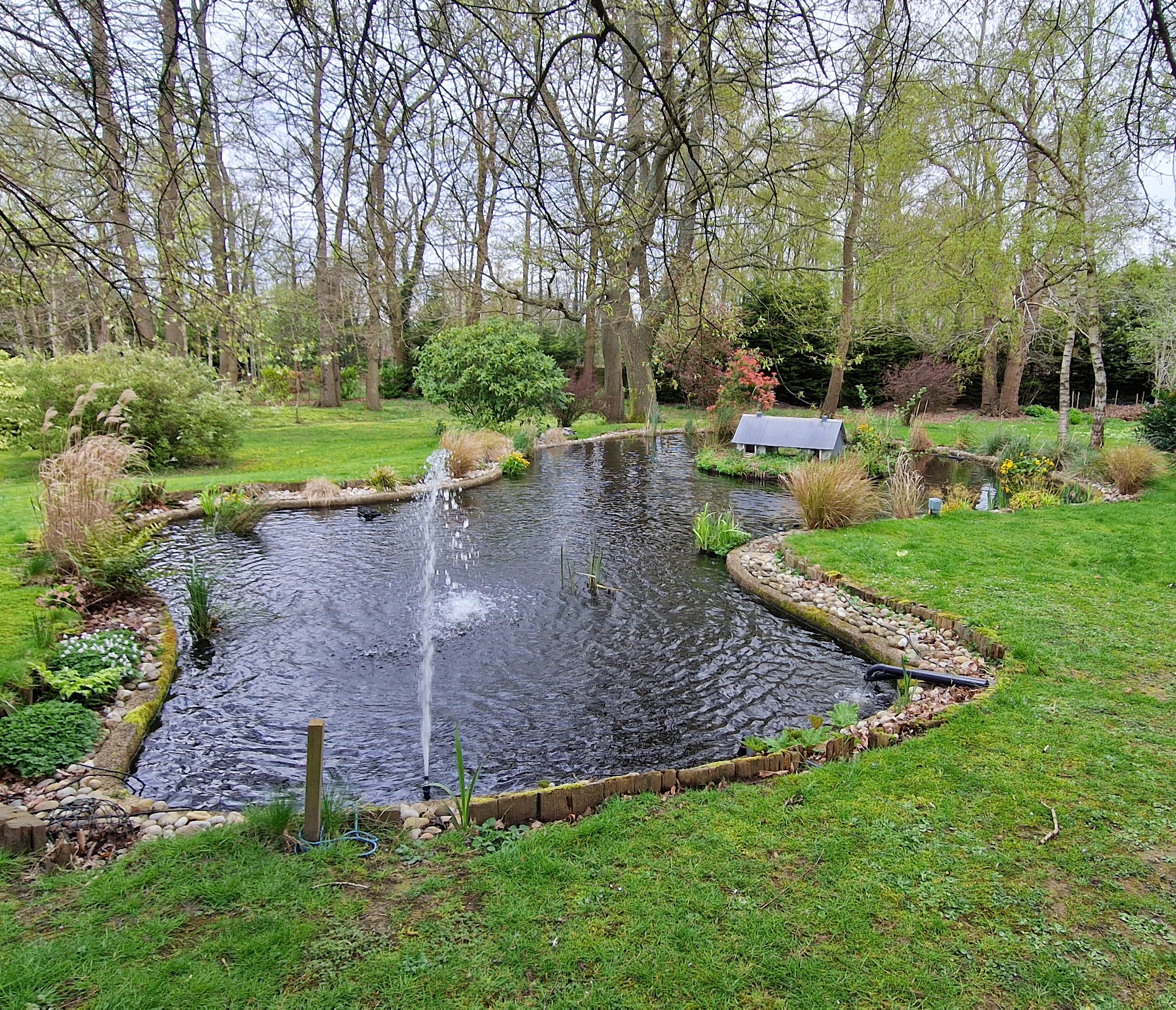
Preparing Your Pond for Spring, Summer, Autumn and Winter
Understanding how your pond changes and evolves over time is a crucial aspect of maintaining a healthy and vibrant pond ecosystem and one that can easily trip you up if you aren’t careful. As the seasons change, so do the needs of your pond. Each season brings unique challenges and opportunities, requiring a tailored approach to ensure the health and beauty of your aquatic haven.
Whether you’re a seasoned pond owner or a newcomer to this rewarding hobby, understanding the seasonal nuances in pond care management is crucial. From the awakening of life in spring to the tranquillity of winter, your pond is a dynamic system that demands attention and care. This article provides comprehensive guidance on preparing and maintaining your pond throughout the year, helping you ensure a happier and healthier life for your fish.
General Tips for Every Season
While no two days of pond care are the same, there are plenty of things you should be doing on a routine basis to help manage and maintain your pond throughout the year. One of the most critical aspects is monitoring water quality. Regular testing for pH, ammonia, nitrite, and nitrate levels helps maintain a balanced ecosystem, crucial for the health of fish and plants. Keeping the pond clean is another ongoing task and while this can change over the seasons, regular cleaning is still required all year round. Regular removal of debris, such as leaves and twigs, prevents the accumulation of organic matter that can lead to water quality issues. These smaller cleans also help to reduce the need for a full scale clean which you should ideally limit to one or twice a year.
It’s also vital to inspect and maintain pond equipment, including pumps, filters, and lighting, to ensure they function correctly. Regular checks of every few months for all equipment can help keep performance optimal and reduce the chance of issues rising before you can react to them. You should avoid over-disturbance wherever possible but cleaning 2-3 times a year is generally recommended, depending on the type of equipment you have.
There’s no secret trick to pond care or exact science. As long as you are maintaining a regular routine, keeping an eye on things and keeping your water and equipment clean regularly, you’ll be on to a winner. These general practices form the foundation of seasonal pond care, setting the stage for more specific maintenance tasks as the year progresses and with a seasonal change, you’ll often find that you are simply just doing a bit more of a regular task, instead of completely revamping your set-up.
Seasonal Pond Care for Spring
Spring is a really important time for pond maintenance, possibly the most important time of the year. As temperatures rise, it’s crucial to give your pond a thorough spring cleaning. Start by removing any netting used during the fall and winter months. Clean out debris and sludge that accumulated over the winter to prevent excessive nutrient build-up, which can fuel algae growth. Check all pond equipment, including pumps, filters, and UV clarifiers, to ensure they are in good working order after the winter hiatus.
This is also the time to reintroduce plants and wildlife to your pond. Gradually reintroduce fish to the pond environment if they were housed indoors during winter. Begin feeding them a high-quality diet, but do so sparingly at first as their metabolism is still adjusting. Trim and repot aquatic plants as needed, and consider adding new plants to enhance your pond’s ecosystem and appearance. Keep an eye on the water temperature; once it consistently stays above 10-15 degrees Fahrenheit, it’s safe to start adding bacteria and enzymes to help establish a healthy biological balance.
Seasonal Pond Care for Summer
Summer brings its own set of challenges to pond care, primarily due to higher temperatures and increased sunlight. As we start to see bigger temperature spikes and longer periods of high heat, understanding how to prep and maintain your pond will become increasingly important.
Algae control is a significant concern during this period. This is the time of year you should be keeping an eye on your filters and equipment more regularly. A filter clean around July or August is fairly typical. You should also consider using UV clarifiers to manage algae growth. Be vigilant about checking water quality, as fluctuations in pH and nutrient levels can occur more rapidly in the summer. It’s also important to maintain adequate oxygen levels as warmer water holds less oxygen; installing aerators or water features can help keep your pond oxygenated. Also, water evaporation is more pronounced in summer, so monitor and top up the water level as needed. However, avoid using chlorinated tap water directly, as it can harm pond life. If tap water must be used, treat it with a dechlorinator first.
The health of your fish and aquatic plants also requires extra attention. This is the time of year where you will likely need to increase feeding as fish are more active but avoid overfeeding as this can lead to water quality issues. You’ll learn overtime how much is too much. In the same regard, prune and fertilise aquatic plants to encourage healthy and regular growth. You should also consider creating shaded areas when temperatures notably pick up, either with plants or artificial coverings, as this can help regulate water temperature and provide shelter for fish.
Seasonal Care for Autumn
As autumn arrives, preparing your pond for the colder months ahead becomes crucial. Begin by removing fallen leaves and other debris regularly to prevent them from decomposing in the water, which can lead to water quality problems and harm pond life. If you are seeing quite a lot of debris, it is probably worthwhile installing a net over the pond as an effective way to catch falling leaves.
If you started feeding more in the summer, you should immediately start reducing feeding for your fish as their metabolism starts to slow down with the dropping temperatures. Once water temperatures consistently fall below 10 degrees celsius, cease feeding altogether. This is also the time to thin out overgrown aquatic plants and remove any dead or dying foliage.
You should consider installing a pond heater or, at the very least, a de-icer to keep a portion of the pond surface from freezing over, ensuring proper gas exchange throughout the winter. If you have particularly hardy fish or a relatively small pond, a water heater (and the fairly expensive running costs) can be avoided with some focused upkeep but if you are planning on making pond keeping a major hobby or you want to start keeping more exotic tropical fish, a pond heater will become a very useful tool. Also, you should gradually reduce the amount of time your pond’s filtration system is running each day, if applicable, as biological activity decreases in colder water.
Seasonal Care for Winter
Winter is the time of year where your pond is least active so upkeep will naturally die down but that doesn’t mean that maintenance should stop altogether. Key to winter pond care is ensuring the pond does not freeze completely. As discussed above, consider using a pond heater or a de-icer to keep an area of the pond surface open. This open area is vital for gas exchange, allowing harmful gases to escape and oxygen to enter the water, crucial for the survival of fish and beneficial bacteria.
Otherwise, you will want to minimise disturbance to your pond during winter. While working on your pond, avoid walking on frozen ponds, as this can send shock waves through the water, stressing fish. Save the ice skating for the rink! It’s also important to protect your pond equipment. Remove pumps and filters that are not designed to withstand freezing temperatures, and store them safely. If your pond is equipped with a skimmer, clear it of debris to prevent blockages.
Seasonal pond care is crucial for maintaining a healthy and thriving aquatic environment throughout the year. Each season demands specific attention and practices to address its unique challenges. By following these seasonal guidelines, you can ensure your pond remains a vibrant and enjoyable feature of your garden. Regular care, keen observation, and a proactive approach to seasonal changes are the keys to successful pond management. Embrace each season’s distinct beauty and requirements, and your pond will continue to be a source of joy and tranquillity for years to come.





